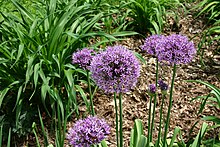Allium aflatunense is a species of plant in the amaryllis family, native to Kazakhstan and Kyrgyzstan in Central Asia. In other regions, it is commonly grown as a garden plant.[1]
| Allium aflatunense | |
|---|---|

| |
| Scientific classification | |
| Kingdom: | Plantae |
| Clade: | Tracheophytes |
| Clade: | Angiosperms |
| Clade: | Monocots |
| Order: | Asparagales |
| Family: | Amaryllidaceae |
| Subfamily: | Allioideae |
| Genus: | Allium |
| Subgenus: | Allium subg. Melanocrommyum |
| Species: | A. aflatunense
|
| Binomial name | |
| Allium aflatunense B. Fedtsch.
| |
Description
editAllium aflatunense is a 0.9 m (36 in) tall bulbous perennial plant with basal, straplike leaves, and hollow, slightly ribbed scapes (flower stems).[1] The flower heads are dense, globular umbels, about 10 cm (4 in) across, made up of numerous star-shaped, purplish-pink flowers.[1] It flowers in May and June, with seeds ripening in August. It is commonly sold as a bulb.
A. aflatunense is often confused with A. hollandicum.[2]
Cultivation
editAllium aflatunense is generally hardy in USDA zones 4–8. The plant is suitable for use as a cut flower. While it prefers alkaline soil, it can tolerate poor soil conditions, as well as part shade (though it does best in full sun).[citation needed]
References
edit- ^ Jump up to: a b c Brickell, Christopher (Editor-in-chief), The Royal Horticultural Society A-Z Encyclopedia of Garden Plants, p.95, Dorling Kindersley, London, 1996, ISBN 0-7513-0303-8.
- ^ RHS Plant Finder 2009–2010, p.68, Dorling Kindersley, London, 2009, ISBN 978-1-4053-4176-9.